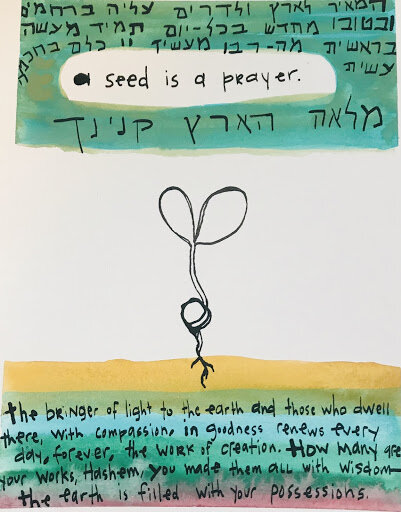A Seed is a Prayer: Blessings for things that grow / Heather Vidmar-McEwen
Background
My project explores ideas of how tiny, mundane things—like seeds, individual letters in a text, the stitches in a garment–can expand, grow, and change to become something unexpected. A seed becomes a plant becomes a flower becomes a grain becomes bread to nourish a family. In every loaf of bread is contained the countless fingerprints human tending—the farmers, the bakers, the truck drivers, the grocery store stockers. And in every atom and strand of DNA and touch by sun and touch by hand is evidence of the divine blessings of Hashem.
This exploration of expanding and contracting scale (seeds, stitches, gardens, communities) led me to consider the text of Birkat Hamazon, the blessing of thanks given after eating bread. How does this familiar text embody the connectedness of life within the systems that sustain us? How can it address the systems that perpetuate injustice? And how can I, with words, images, and actions, unify the process of planting my garden, nurturing my family, and expressing gratitude to Hashem and to all of the people and creatures involved in the making of every moment of our lives?
Traditional Judaism does not offer us a prayer to make upon planting a seed—perhaps because the outcome of that action, the harvest, is so distant, and so many variables can influence the plant’s growth. Instead I explored texts that our tradition has given us about the process of planting and tending to our gardens, and about the many metaphors contained in the word ‘seeds’/זרעים (which can mean seeds that become plants as well as sperm, children/descendants, and the entirety of the Jewish people most generally). I was struck by several things during this exploration. The first is the powerful message of hope that Judaism associates with seeds, encouraging us to plant a tree even if only our great, great grandchildren/future generations will eat from it. The second is the necessity of devotion to tending of the garden, through consistent attention and action, despite whatever mishaps we encounter. Finally, we are enjoined again and again to express our gratitude to Hashem for the blessings all around us, during daily prayer, before and after our meals, and as we move through our world.
The art I created took many forms, including illuminated texts from Birkat Hamazon and other sources, comics, illustrations, and installations within my garden of the texts of some traditional blessings of gratitude for beautiful things. I also wrote and illustrated a kavana (personal intention/prayer) to be recited upon working in the garden. Much like a sofer (Jewish ritual scribe) must utter an intention before each and every writing session creating a sefer Torah (Torah scroll), I imagined bringing the same sort of quiet, grateful intentionality to the tending tasks in my garden. This will be displayed at the entrance to my garden to be shared with all who visit. Finally, my garden itself is a foundational part of this project. It is ever changing, growing and thriving and succeeding and failing and starting over again, much like the artistic process itself. I do not know where and how the things that I plant will grow, but I may nevertheless not turn away from the work of tending them.
Process
Questions, Sketches, Explorations, Play
Is a seed a prayer?
What is a prayer?
A prayer is words.
A prayer is a request.
A prayer is a question.
A prayer is a promise.
Is a prayer punctuation in a day filled with words and requests and questions and promises?
Is a prayer a tree?
Does it grow roots?
Does it make leaves?
Is it soil?
Does it stain hands and get under fingernails?
A prayer is a knitted garment.
A prayer is a darned sock heel.
A prayer is a hope.
A prayer is a grain, a stitch, a knot, a scrap of fabric.
A prayer is a seed held in a grubby palm.
It is important to have helpers on any journey…Stitches, seeds, letters, leaves
An invitation
Share and nurture the seeds of blessings. Discuss the following text. Who will benefit from the seeds you plant? Fill a pomegranate to bursting with hopes and intentions for a friend, for a new project, for yourself, for your world. You may use this illustration and add one or more blessings to each seed, or share an actual fruit and as you encounter the seeds say your blessings in your heart and/or out loud. Experiment with different fruits including pomegranates, citrus, apples, watermelons.
Adapted from Talmud Bavli, Taanit 23a
Rabbi Yochanan tells the story of a righteous man, Choni, who was walking along a path and saw a person planting a carob tree. Choni asked them, “How many years will it be until this tree bears fruit?” They replied that it would take seventy years to harvest carob pods from the tree. Choni was surprised, because the person planting was old. He said to them, “Do you expect to live seventy more years so that you will benefit from the fruit produced by this tree?” And the person said, “As a child I found the world filled with beautiful trees, bearing delicious fruit, all planted for me by my ancestors. Just as my ancestors planted for me, I too am planting for my descendants.”





